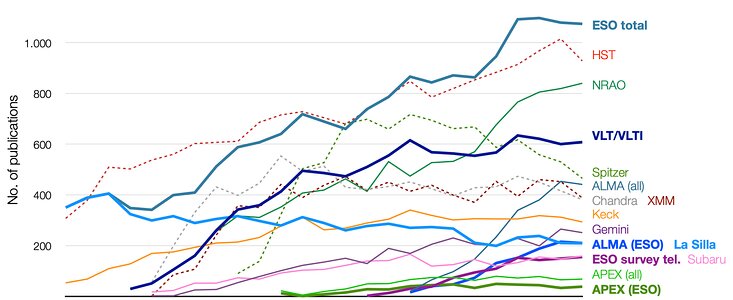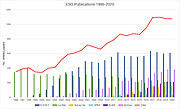Meddelelse
Over 1000 studies using ESO data: a look back at ESO’s science results of 2020
20. maj 2021
ESO observatories operated under challenging conditions in 2020 due to the unprecedented COVID-19 pandemic, having to reduce and even pause scientific observations for a few months. Nonetheless, 2020 was still a very productive year for the observatory with regard to the number of papers that were published using data from ESO telescopes, mostly obtained in previous years. A recently published report from the ESO library shows that 2020 represents the fourth consecutive year that over 1000 scientific studies using ESO data were published.
The majority of these publications, more than 600, used data from ESO’s flagship facility, the Very Large Telescope (VLT), and the VLT Interferometer (VLTI). Highlights include the first ever image of a multi-planet system around a Sun-like star and observing a star “dance” around a supermassive black hole.
Of the 608 studies carried out using observations from the VLT and VLTI, 336 (55%) used data from the Multi Unit Spectroscopic Explorer (MUSE), the Ultraviolet-Visual Echelle Spectrograph (UVES), or from the X-shooter spectrograph. These were the three most productive VLT instruments in 2020, as was the case in 2019.
Data from the survey telescopes at ESO’s Paranal Observatory in northern Chile, the Visible and Infrared Survey Telescope for Astronomy (VISTA) and the VLT Survey Telescope (VST), led to over 150 published papers in 2020, in line with previous years. One result, which used data from the VST, combined with data from ESO’s VLT and the New Technology Telescope, showed how hot stars are plagued by giant magnetic spots.
Approximately 200 papers were published using data obtained from ESO’s oldest observatory, La Silla. Of these, a significant portion (122) came from the High Accuracy Radial velocity Planet Searcher (HARPS), an instrument mounted on ESO’s 3.6-metre telescope that is dedicated to the search for, and study of, exoplanets.
The Atacama Large Millimeter/submillimeter Array (ALMA), in which ESO is a partner, provided data for over 440 papers. Almost half (48%) of these used data obtained during European ALMA time. An example includes a study on the interstellar thread of one of life’s building blocks, published in January 2020.
ESO is also a partner in the Atacama Pathfinder Experiment (APEX), which is located near ALMA on the Chajnantor plateau in Chile’s Atacama region. In 2020, observations obtained during ESO observing time at APEX contributed to more than half (56%) of papers from all APEX observing time.
For the second year running, more than a third (36%) of all ESO data papers published in 2020 used observations that came partly or exclusively from the ESO Science Archive. This highlights the fact that past observations continue to be used by astronomers and lead to further breakthroughs in science — sometimes years after they have initially been taken. Although data obtained this year will be lower due to the closure of observatory sites, older ESO data is still being used and will continue to contribute to astronomy.
These impressive publication numbers highlight ESO’s important role in helping astronomers further our knowledge of the Universe. Comparing publication statistics for ESO and other observatories is complicated by the fact that different institutes use different methods to count scientific studies; nonetheless, ESO has remained the world’s most productive ground-based observatory in 2020, with over 1000 papers published using ESO data.
More Information
The figures are published in the annual Basic ESO Publication Statistics published by ESO’s Library and Information Centre and calculated using the ESO Telescope Bibliography (telbib), a database containing refereed publications that use ESO data. ESO makes extensive efforts to identify all refereed papers that use ESO data and considers telbib essentially complete.
Interactive graphs of selected statistics are available online. These graphs display the entire content of the telbib database, which contains records for publications from 1996 to the present. They can be used to explore many aspects of the publication history, including the development of science papers using data from ESO instruments and the use of archival data.
ALMA, an international astronomy facility, is a partnership of ESO, the U.S. National Science Foundation (NSF) and the National Institutes of Natural Sciences (NINS) of Japan in cooperation with the Republic of Chile.
Links
Kontakter
Uta Grothkopf
ESO Librarian
Garching bei München, Germany
Email: uta.grothkopf@eso.org
Bárbara Ferreira
ESO Media Manager
Garching bei München, Germany
Tel: +49 89 3200 6670
Email: press@eso.org
Om meddelelsen
| Id: | ann21006 |
Our use of Cookies
We use cookies that are essential for accessing our websites and using our services. We also use cookies to analyse, measure and improve our websites’ performance, to enable content sharing via social media and to display media content hosted on third-party platforms.
ESO Cookies Policy
The European Organisation for Astronomical Research in the Southern Hemisphere (ESO) is the pre-eminent intergovernmental science and technology organisation in astronomy. It carries out an ambitious programme focused on the design, construction and operation of powerful ground-based observing facilities for astronomy.
This Cookies Policy is intended to provide clarity by outlining the cookies used on the ESO public websites, their functions, the options you have for controlling them, and the ways you can contact us for additional details.
What are cookies?
Cookies are small pieces of data stored on your device by websites you visit. They serve various purposes, such as remembering login credentials and preferences and enhance your browsing experience.
Categories of cookies we use
Essential cookies (always active): These cookies are strictly necessary for the proper functioning of our website. Without these cookies, the website cannot operate correctly, and certain services, such as logging in or accessing secure areas, may not be available; because they are essential for the website’s operation, they cannot be disabled.
Functional Cookies: These cookies enhance your browsing experience by enabling additional features and personalization, such as remembering your preferences and settings. While not strictly necessary for the website to function, they improve usability and convenience; these cookies are only placed if you provide your consent.
Analytics cookies: These cookies collect information about how visitors interact with our website, such as which pages are visited most often and how users navigate the site. This data helps us improve website performance, optimize content, and enhance the user experience; these cookies are only placed if you provide your consent. We use the following analytics cookies.
Matomo Cookies:
This website uses Matomo (formerly Piwik), an open source software which enables the statistical analysis of website visits. Matomo uses cookies (text files) which are saved on your computer and which allow us to analyze how you use our website. The website user information generated by the cookies will only be saved on the servers of our IT Department. We use this information to analyze www.eso.org visits and to prepare reports on website activities. These data will not be disclosed to third parties.
On behalf of ESO, Matomo will use this information for the purpose of evaluating your use of the website, compiling reports on website activity and providing other services relating to website activity and internet usage.
Matomo cookies settings:
Additional Third-party cookies on ESO websites: some of our pages display content from external providers, e.g. YouTube.
Such third-party services are outside of ESO control and may, at any time, change their terms of service, use of cookies, etc.
YouTube: Some videos on the ESO website are embedded from ESO’s official YouTube channel. We have enabled YouTube’s privacy-enhanced mode, meaning that no cookies are set unless the user actively clicks on the video to play it. Additionally, in this mode, YouTube does not store any personally identifiable cookie data for embedded video playbacks. For more details, please refer to YouTube’s embedding videos information page.
Cookies can also be classified based on the following elements.
Regarding the domain, there are:
- First-party cookies, set by the website you are currently visiting. They are stored by the same domain that you are browsing and are used to enhance your experience on that site;
- Third-party cookies, set by a domain other than the one you are currently visiting.
As for their duration, cookies can be:
- Browser-session cookies, which are deleted when the user closes the browser;
- Stored cookies, which stay on the user's device for a predetermined period of time.
How to manage cookies
Cookie settings: You can modify your cookie choices for the ESO webpages at any time by clicking on the link Cookie settings at the bottom of any page.
In your browser: If you wish to delete cookies or instruct your browser to delete or block cookies by default, please visit the help pages of your browser:
Please be aware that if you delete or decline cookies, certain functionalities of our website may be not be available and your browsing experience may be affected.
You can set most browsers to prevent any cookies being placed on your device, but you may then have to manually adjust some preferences every time you visit a site/page. And some services and functionalities may not work properly at all (e.g. profile logging-in, shop check out).
Updates to the ESO Cookies Policy
The ESO Cookies Policy may be subject to future updates, which will be made available on this page.
Additional information
For any queries related to cookies, please contact: pdprATesoDOTorg.
As ESO public webpages are managed by our Department of Communication, your questions will be dealt with the support of the said Department.


